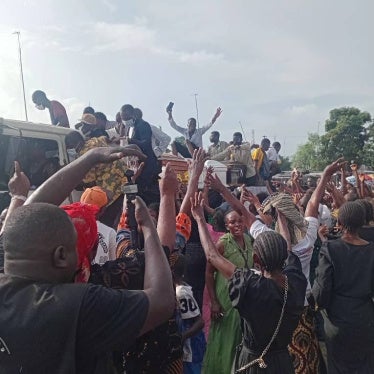In a joint operation in the Darfur region of Sudan, government troops working with Arab militias detained 136 African men whom the militias massacred hours later, Human Rights Watch said today.
Human Rights Watch has documented dozens of attacks by Arab militias, known as janjaweed, in almost a month of research inside Darfur. All but two of the attacks were carried out in conjunction with government forces.
"The janjaweed are no longer simply militias supported by the Sudanese government," said Kenneth Roth, Executive Director of Human Rights Watch. "These militias work in unison with government troops, with total impunity for their massive crimes."
The 136 men, all members of the Fur ethnic group aged between 20 and 60, were rounded up in early March in two separate sweeps in the Garsila and Mugjir areas in Wadi Saleh. They were then taken in army lorries to nearby valleys where they were made to kneel before being killed with a bullet in the back of the neck.
Most of those killed had sought refuge in the Garsila and Mugjir areas after their villages were burned and pillaged by government troops and janjaweed militiamen under the command of Ali Kwoshib, janjaweed commander in the Jebel Marra area.
Human Rights Watch said many janjaweed fighters are organized into battalions that have the same structure as those in the government army. They use the same weapons as regular soldiers and their leaders wear stripes on their uniforms that are identical to those of the regular army. An increasing number of janjaweed fighters wear the same uniforms as government soldiers. The only difference is that the janjaweed uniforms have a breast pocket badge depicting an armed man on horseback.
Operations carried out by the janjaweed often enjoy air support from the government of Sudan, both aerial bombardment before operations and helicopter reconnaissance afterwards to ensure the area is empty. In many villages, regular troops and janjaweed forces establish a joint presence—often in the local police station—before going out to burn and pillage.
On the same day as the two massacres, March 5, nine Fur omdas (chiefs) who had been arrested a week earlier were shot dead in government prisons in Garsila and Mugjir. Their families reported their deaths after being told to collect their bodies for burial.
Villagers from the Garsila area told Human Rights Watch that they woke up on March 5 to find an area encompassing 32 villages surrounded by government troops and janjaweed. The government and militia forces then entered the villages and began asking men where they came from. One hundred and four individuals—most of them people who had been displaced from villages in the Zamey area south of Deleig—were taken to the government prison in Deleig, northeast of Garsila. That same night, according to local people, 72 of the 104 were loaded into army trucks and driven two kilometers to a valley where they were executed.
Human Rights Watch said that thirty-two of the men also rounded up in the Garsila sweep are still in detention, believed to be at risk of torture and death.
Among the other 72, there was one survivor: a man left for dead. He crawled back to Deleig after the massacre, reaching the village in the early hours of March 6, when he alerted local people to the killings. One of those he spoke to told Human Rights Watch the government and janjaweed forces appeared to be targeting the populations of villages that had been destroyed in an orgy of burning that began after Ali Kwoshib established a janjaweed base in Garsila in July 2003. The survivor, who is recovering in Deleig and cannot be named, said he and the others selected for execution were taken to the valley in army trucks and cars, "with janjaweed on horses" accompanying the government forces.
Another 65 men were reportedly executed in a similar operation in the Mugjir area some 80 kilometers east of Garsila. Details of this killing are not available because there were no survivors.
The Wadi Saleh massacres conform to a well-established pattern of joint operations by government and janjaweed forces. Until early this year, the janjaweed had the support but not the active participation of the government army in their operations. In recent months, however, the vast majority of the attacks against the African population of Darfur have been joint attacks by the regular army and the militias.
As Sheikh Abdullah Mohammed Hussein, the headman of Terbeba village, said after a joint government-janjaweed attack that killed 31 people and wounded 12 in Terbeba, "They come together, they fight together and they leave together."
"It is imperative that all janjaweed forces withdraw from villages they have occupied and any barracks or garrisons nearby," said Roth. "Unless this happens, refugees and displaced people will never return to their farms and villages, whether there is a ceasefire in place or not."








